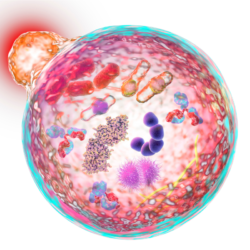Per- and polyfluoroalkylated substances (PFAS) are chemical compounds that have been used in a wide range of industrial products for over 70 years. Known for their resistance to heat, water and grease, PFAS are found in food packaging, textiles, fire-fighting foams and even cosmetics. However, there is growing concern about their persistence in the environment and their tendency to accumulate in living organisms. Among the most worrying undesirable effects, the accumulation of these substances in the human brain is a still unknown but potentially devastating threat.
PFAS: a persistent threat to the environment and health
PFAS are sometimes referred to as “eternal chemicals” because of their high resistance to natural degradation. Their bioaccumulative nature means that they accumulate in human tissues over time, particularly in vital organs such as the liver, kidneys and, more recently, the brain. Studies have linked them to serious health problems, including hormone disruption, immune dysfunction, cancer and neurological disorders. But how do these compounds get into the brain, an organ that is protected by the blood-brain barrier?
What is the blood-brain barrier (BBB)?
The blood-brain barrier (BBB) is a protective structure that surrounds the brain, carefully regulating the substances that can enter it from the bloodstream. Its main role is to prevent toxins and pathogens from reaching brain cells, while allowing essential nutrients to pass through. However, PFAS have the unique ability to break through this protective barrier, accumulating in the brain. But how do they manage to bypass this natural protection?
Can PFAS cross the blood-brain barrier?
Recent research has revealed that certain exogenous substances, including PFAS, can indeed cross the BBB. This probably occurs via specific transporters or through exchanges in the cerebral circulation. Once they have crossed this barrier, PFAS accumulate in brain tissue, potentially causing long-term damage. This process is of particular concern because it makes PFASs capable of directly influencing the functioning of the central nervous system.
Not all PFAS cross the BBB equally. Studies show that low-molecular-weight PFASs, including short-chain PFASs, have a greater capacity to accumulate in the brain than long-chain PFASs. For example, research on glioma patients has shown that compounds such as 6:2 chlorofluorethylsulphonate (6:2 Cl-PFESA) and PFOS (perfluorooctane sulphonic acid) accumulate significantly in brain tissue, suggesting that the chemical substitutes used to replace traditional PFASs are not necessarily safer.
PFAS accumulation in the brain: What studies show
In a pilot study, plasma and brain tissue samples from glioma patients were analysed for the presence of 17 types of PFAS. The results showed that low-molecular-weight PFASs, including some emerging PFASs, have a higher capacity to accumulate in the brain than long-chain PFASs. This accumulation is all the more alarming because these substances can persist in brain tissue for long periods, exposing the brain to prolonged toxic effects.
One of the most worrying findings about PFASs is their potential link to the development of neurological diseases, including brain tumours. For example, the study showed a strong correlation between the concentration of FOSA (perfluorooctane sulphonamide) in the brain and the progression of gliomas, a form of malignant brain tumour. Although the evidence is not yet sufficient to establish a direct causal link, the results suggest that PFAS may play a role in the onset and progression of brain tumours.
Studies show that BBB permeability can vary with age. In fact, researchers have observed that the transmission efficiency of PFAS across the BBB tends to increase with age, which could explain why older people are more vulnerable to the toxic effects of PFAS on the brain. This finding underlines the importance of monitoring PFAS in ageing populations, particularly with regard to neurological risks.
Natural strategies to reduce exposure to PFAS
There are currently no specific natural remedies for eliminating PFAS from the human body, as these substances are extremely persistent and difficult to break down. However, several natural approaches can help limit exposure and support the body’s natural detoxification mechanisms.
- Water filtration: Using specific filters such as activated carbon or reverse osmosis filters can considerably reduce exposure to PFAS in drinking water. These filters are recommended because PFAS frequently contaminate water.
- Avoid products containing PFAS: Reducing the use of everyday consumer products containing PFAS, such as non-stick pans (Teflon type), food packaging, and water- and stain-resistant textiles, can limit exposure.
- Eating a diet rich in antioxidants: Although not directly eliminating PFAS, a diet rich in natural antioxidants, fruit, vegetables and fibre can support the natural detoxification processes of the liver and kidneys, helping the body to manage general toxins.
- Take precautions at home: Regular dusting and the use of hoovers fitted with HEPA filters can help reduce exposure to PFAS present in household dust, a major source of contamination.
Sources
- Per- and polyfluoroalkyl substances (PFAS) exposure in plasma and their blood-brain barrier transmission efficiency-A pilot study
- Concern Over the “Forever Chemical” PFAS Is High, But Remedies Remain Remote
- Harvard – Protecting against ‘forever chemicals





